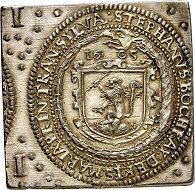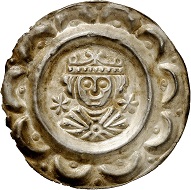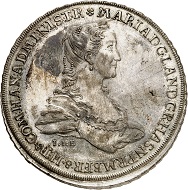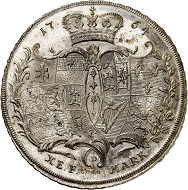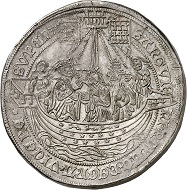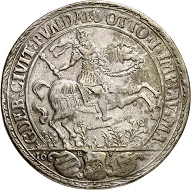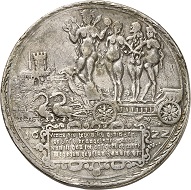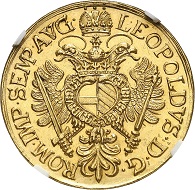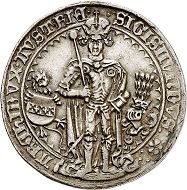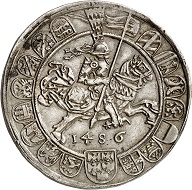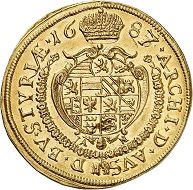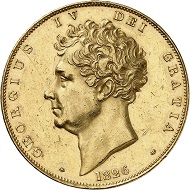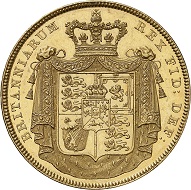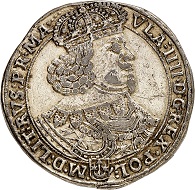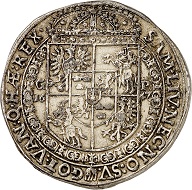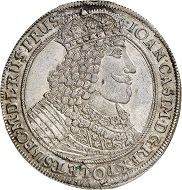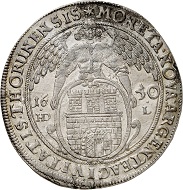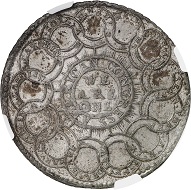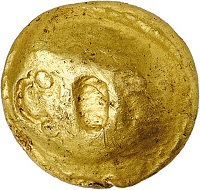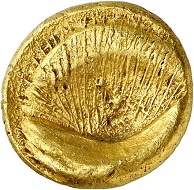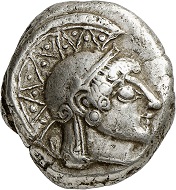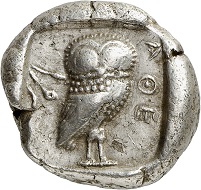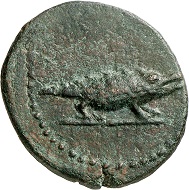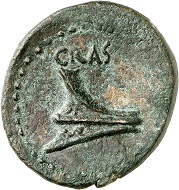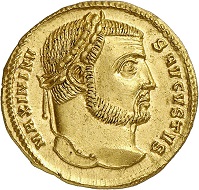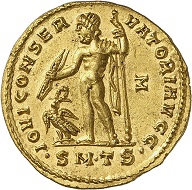10-10-2017 – 14-10-2017
Auctions 249-250, E-Auction 251
Record prices at Gorny & Mosch’s 250th auction
On November 16, 1970, Auction No. 1 of the Giessener Münzhandlung took place. Today this Munich-based auction house is called Gorny & Mosch and constitutes an important element of the international coin market. Since 1970, the auction house has published at least two auction catalogues every year. This year, on October 12, No. 250 was released. This turned out to be a splendid opportunity for a numismatic celebration. As a matter of fact, the select coins and medals dating from the Middle Ages and modern times, which were listed in the 250th auction catalogue, yielded more than one pleasant surprise.
Lot 3415: Transylvania. Stephen Bocskai, 1604-1606. 1 1/2 taler klippe 1605, Nagybanya. Very rare. Old gilding, otherwise extremely fine. Estimate: 4,000,- euros. Hammer price: 65,000,- euros.
Transylvania
A 1 1/2 taler klippe of Transylvanian Prince Stephen Bocskai, which exhibited old gilding but was otherwise extremely fine, became the auction’s high flyer. Starting with an estimate of 4,000 euros, it rose to 65,000 euros. That was an outlier all right, but an outlier at a high level. All 16 coins from Transylvania were in great demand. The total estimate amounted to 46,500 euros; the hammer price was an impressive 141,100 euros! And that was certainly not the only section that recorded high prices.
Lot 2030: Donauwörth. Philip – Otto IV – Friedrich II, 1198-1208-1215-1250. Bracteate. 2nd known specimen on the market. Extremely fine. Estimate: 4,000,- euros. Hammer price: 8,500,- euros.
Medieval times
Let’s start with the highlights from the Middle Ages: two magnificently preserved bracteates from Donauwörth of the highest rarity. Lot 2028 (Steinhilber 108) had been estimated at 5,000 euros, only to rise to 7,500 euros, Lot 2030 (neither in Steinhilber nor in Gebhard) did not fetch the estimated 4,000 euros, but more than doubled it with its 8,500 euros.
Lot 2151: Bavaria. Karl Theodor, 1777-1799. Isargold ducat 1780, Munich. Very rare. Almost FDC. Estimate: 12,500,- euros. Hammer price: 22,000,- euros.
German states
The prices for coins and medals of the German states were remarkable, regardless of whether or not the object was a great rarity. Let’s take a look at the 44 pieces from the Imperial City of Augsburg, all of them of extraordinarily good quality. Their total estimate added up to 27,000 euros, the hammer price to 42,000 euros.
Especially the superbly preserved coins made of river gold attracted the collectors’ attention. Graded almost FDC, the Bavarian Isargold ducat from 1780, for instance, cost 22,000 euros (estimate: 12,500 euros), another one from 1821 in extremely fine to FDC 14,000 euros (estimate: 10,000 euros), and the 1830 Inngold ducat in almost extremely fine 7,500 euros (estimate: 4,000 euros).
Lot 2432: Hanau-Münzenberg. Maria von Braunschweig, 1760-1764. Konventionstaler 1764, Hanau. Extremely rare. First strike. FDC. Estimate: 20,000,- euros. Hammer price: 24,000,- euros.
The 1764 konventionstaler featuring the portrait of Maria von Braunschweig, who ruled on behalf of her son, Wilhelm IX of Hanau, became the most expensive piece of the series from Hanau-Münzenberg. The first strike of the series with a mintage of no more than 18 specimens had been estimated at 20,000 euros, to finally hammer at 24,000 euros.
Lot 2519: Cologne, city. Triple dreikönigstaler no date (1610-1620). Probably unique. Extremely fine. Estimate: 4,000,- euros. Hammer price: 19,000,- euros.
The attendees of the auction witnessed two surprises in a row when the coins from the city of Cologne were called out. Minted between 1610 and 1620 and graded extremely fine, a probably unique triple dreikönigstaler no date had been estimated at 3,200 euros but obtained 19,000 euros in the end. The next piece, also a dreikönigstaler of normal taler-weight, realized “only” 3.5 times its estimate of 2,000 euros. It sold for 7,000 euros in the end.
Lot 2533: Magdeburg, city. Double taler 1622. So-called “hurenkarren” taler. Very fine to extremely fine. Estimate: 7,500,- euros. Hammer price: 14,000,- euros.
Minted in 1622 and graded very fine to extremely fine, the so-called “hurenkarren” taler from Magdeburg fetched 14,000 euros (estimate: 7,500 euros).
Lot 2594: Regensburg, city. 4 ducats 1664. Very rare. Graded NGC MS63. Extremely fine to FDC. Estimate: 20,000,- euros. Hammer price: 32,000,- euros.
The most expensive German coin of the sale came from Regensburg. Described as MS63 by NGC, the 4 ducat piece from 1664 had been estimated at 20,000 euros and changed hands for 32,000 euros.
Lot 2978: Holy Roman Empire. Archduke Sigismund, 1439-1490. Guldiner 1486, Hall. Very rare. Extremely fine. Estimate: 10,000,- euros. Hammer price: 19,000,- euros.
Holy Roman Empire
The lots from the Holy Roman Empire registered high prices as well. The popular 1486 guldiner of Sigismund Rich in Coins made a collector gladly pay 19,000 euros. An FDC 1687 double ducat of Leopold I brought 17,000 euros (estimate: 15,000 euros).
Lot 3011: Holy Roman Empire. Leopold I, 1657-1705. Double ducat 1687, Graz. Very rare. FDC. Estimate: 15,000,- euros. Hammer price: 17,000,- euros.
Graded FDC, an extremely rare oval silver medal of the Salzburg Archbishop Gandolf von Küenburg on his 1668 accession to power crossed the auction block for 14,000 euros (estimate: 7,500 euros). Compared against that, a 1629 thick double taler of the Eggenberg dynasty appeared almost inexpensive when it hammered at 8,000 euros (estimate: 7,500 euros).
Lot 3231: Great Britain. George IV, 1820-1830. 5 pounds 1826, London. Only 150 specimens struck. From polished dies. Extremely fine / Extremely fine to FDC. Estimate: 25,000,- euros. Hammer price: 30,000,- euros.
Foreign countries
We cannot list each and every impressive result achieved by foreign coins and medals. That would go beyond the scope of this review. Suffice it to note, then, that Polish coins were just as popular as those from Transylvania.
Lot 3310: Poland. Wladyslaw IV, 1632-1648. Thick double taler 1647, Cracow. Extremely rare. Old gilding, otherwise very fine. Estimate: 5,000,- euros. Hammer price: 32,000,- euros.
Thus, a medal of Sigismund III on his 1630 abdication as King of Sweden realized 22,000 euros (estimate: 7,500 euros), whereas a 1647 thick double taler of Wladislaw IV, minted in Cracow and graded “only” very fine due to its old gilding, brought 32,000 euros on an estimate of 5,000 euros.
Lot 3319: Thorn, city. Taler 1650. Very rare. Extremely fine. Estimate: 1,000,- euros. Hammer price: 10,000,- euros.
10,000 euros was the price of an extremely fine 1650 taler from the city of Thorn with the portrait of Johann Casimir; and that was exactly ten times its pre-sale estimate.
Lot 3483: USA. Continental Currency. Pewter Continental Dollar 1776. Extremely rare. Graded NGC MS60. Extremely fine. Estimate: 40,000,- euros. Hammer price: 48,000,- euros.
Let’s close the review of Auction 250 with two results for US American coins. The pewter 1776 Continental Dollar ended at 48,000 euros (estimate: 40,000 euros), the 1851 Californian 50 dollars at 22,000 euros (estimate: 15,000 euros).
Lot 18: CELTS. Boii. “Muschelstater”, 2nd / 1st cent. BC. Extremely fine. Estimate: 2,800,- euros. Hammer price: 6,500 euros.
Auction 249 – Ancient coins
The day before, Auction 249 had taken place, comprising ancient coins. 1105 lots were offered, representing the Celtic, the Greek, the Roman, and the Byzantine era. Prices were stable, albeit not spectacular. 6,500 euros for an extremely fine “Muschelstater” of the Boii is a high, though not exorbitant result (estimate: 2,800 euros), as are the 11,000 euros for an Archaic didrachm from Kaulonia (estimate: 7,500 euros) or the 14,000 euros for an Athenian tetradrachm from Archaic times (estimate: 6,000 euros).
Lot 237: Athens (Attica). Tetradrachm, 500/490-485/480 BC. Almost extremely fine. Estimate: 6,000,- euros. Hammer price: 14,000,- euros.
Roman Provincial coinage yielded some surprises. Who would have guessed, for instance, that the inconspicuous bronze from Knossos depicting the crocodile on the obverse and the prora on the reverse would obtain 4,400 euros (estimate: 500 euros)? The reason for this price surge: The magistrate named on the coin, famous triumvir Crassus, is only rarely encountered on coins.
Lot 409: Knossos (Crete). Crassus, ca. 37-36 BC. AE. Very fine. Estimate: 500,- euros. Hammer price: 4,400,- euros.
Denominations are equally rarely written on ancient coins. A bronze coin from Chios, which was actually inscribed “obolos”, rose from its estimate of 600 euros to a hammer price of 3,000 euros. After all, the rare 2nd century AD piece had been graded extremely fine.
Lot 931: Maximinus Daia, AD 310-313. Aureus, 311-313, Thessaloniki. Extremely fine to FDC. Estimate: 12,000,- euros. Hammer price: 16,000,- euros.
The gold coins of the Tetrarchs also fetched good prices: An FDC aureus of Diocletian crossed the auction block for 11,000 euros (estimate: 7,500 euros) while an extremely fine to FDC aureus of Maximinus Daia obtained 16,000 euros (estimate: 12,000 euros), and an FDC aureus of Licinius 13,000 euros (estimate: 12,000 euros).
Auction 251: E-Auction
On October 15, 2017, Gorny & Mosch conducted its first e-auction under No 251. Again, prices were very fair. To give you just one example: Coins from Tarentum are not rare. 45 of these were to be found in e-auction 251. The total estimate added up to 8,500 euros, which is roughly 188 euros per coin. The hammer price was 9,600 euros, thus 213 euros per coin. This even includes the only piece of this series that was not sold.
Rare and attractive coins fetched prices that were just as good as in a public auction. Thus, an antoninianus of Aurelian with a rare bust rose from 100 to 700 euros, and a very fine maiorina of Nepotianus from 1,500 to 3,600 euros.
Sensibly assembled as always, the multiple lots attracted a great deal of interest. And of course, there also were bargains among the offered coins just like collectors love to find them. And so, one of them can now boast of an aureus of Augustus that once formed part of the Comte René Philipon Collection (1870-1936). He only had to spend 1005 euros to acquire the ancient gold coin.
All results can be viewed online. To consign to the upcoming auction, contact Gorny & Mosch, Giessener Münzhandlung, Maximiliansplatz 20, D-80333 Munich, phone +49 / (0)89 / 24 22 643-0, fax +49 / (0)89 / 22 85 513.




